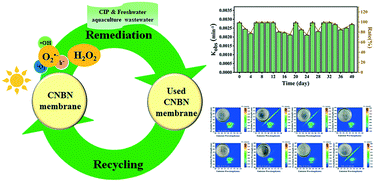Photocatalytic degradation of ciprofloxacin in freshwater aquaculture wastewater by a CNBN membrane: mechanism, antibacterial activity, and cyclability†
Abstract
The increasing emergence of contaminants in freshwater aquaculture wastewater is of growing ecotoxicological concern. Herein, a carbon nitride modified boron nitride (CNBN) membrane was synthesized by moulding the nanosized CNBN into membrane shape, which was applied to remediate contaminated aquaculture wastewater sustainably. It was confirmed through characterization studies that the structure and properties of CNBN were retained after moulding to membrane shape. Under simulated sunlight, the CNBN membrane had effective degradation activity on ciprofloxacin (CIP) and other emerging contaminants in freshwater aquaculture wastewater. The degradation of CIP followed first-order kinetics, where O2˙−, ˙OH, and h+ played major roles during the degradation process. Compared with ultrapure water, the quantity of ˙OH in the freshwater aquaculture wastewater decreased significantly, attributed to the non-selective degradation properties of ˙OH. Coexisting substances, including HA, Mg2+, Ca2+, NO3−, NO2−, and Cl−, were observed to inhibit the photocatalytic activities of the CNBN membrane. The CIP transformation pathways mainly occurred via shedding of functional groups and ring-opening reactions. By simulating the long-term application of the CNBN membrane for the remediation of freshwater aquaculture wastewater, it was observed to maintain stable photocatalytic efficacy for the degradation of CIP for at least 40 days. In addition, the capacities of the CNBN membrane for the removal of antibiotic properties were elucidated. Ultimately, the excellent photocatalytic cyclability and prolonged performance of the CNBN membrane in freshwater aquaculture wastewater verified its potential application prospects.

- This article is part of the themed collection: Environmental Remediation


 Please wait while we load your content...
Please wait while we load your content...